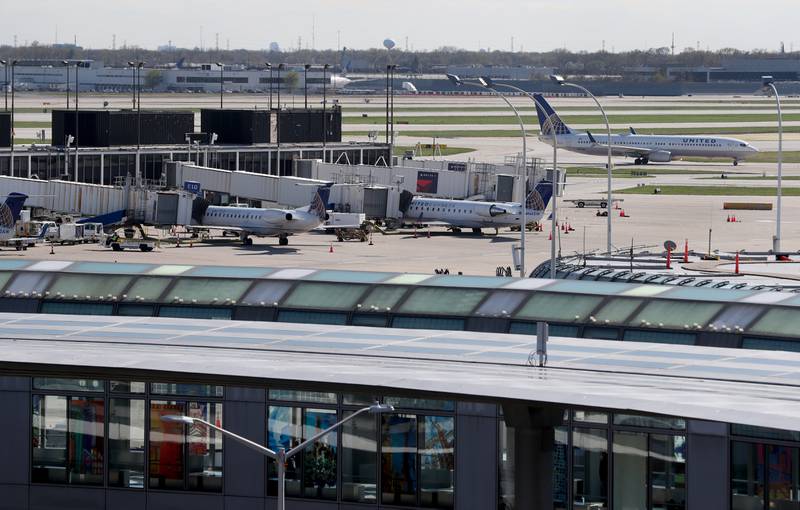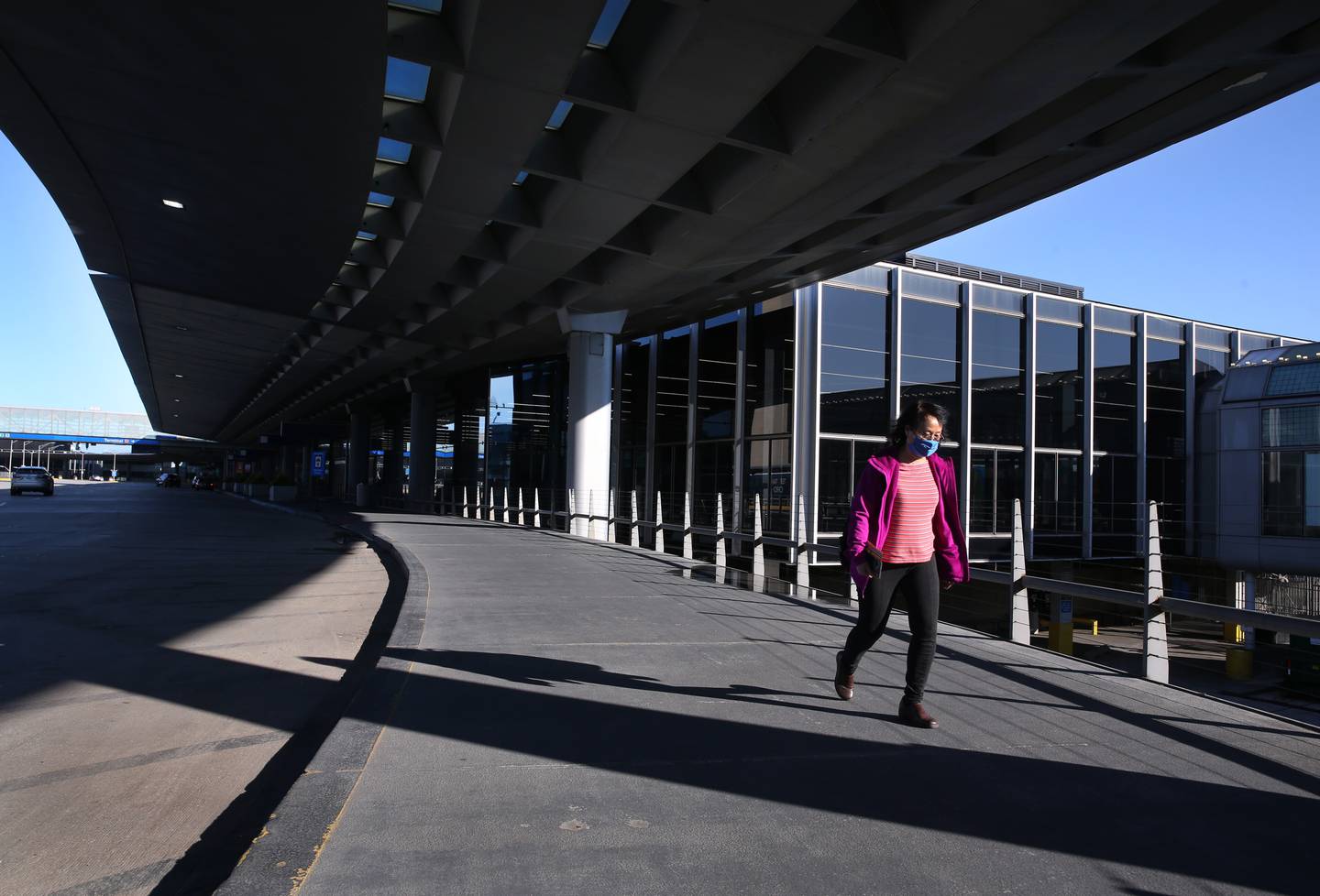Bleak outlook for air travel could force O’Hare’s massive $8.5 billion expansion project to scale back

A United Airlines plane taxis as United Express planes sit at their gates at Terminal 2 of Chicago’s O’Hare International Airport on April 30, 2020. Plans to expand the airport could be jeopardized by the coronavirus pandemic’s effect on air travel. (Chris Sweda/Chicago Tribune)
Chicago’s Aviation Department insists the coronavirus pandemic won’t curtail its $8.5 billion expansion plan for O’Hare International Airport, but there are growing signs the city will have no choice but to reconsider the project’s scope and timing.
The city is counting on the airlines to help fund the expansion. But with flights canceled, jets grounded and passenger traffic plummeting because of the coronavirus, the airlines face their most severe economic crisis since the Sept. 11, 2001, terrorist attacks.
Travel restrictions and passenger concerns have brought flying to a near halt, resulting in billions of dollars in losses for airlines. The Transportation Security Administration screened 119,629 people at U.S. airports Wednesday, down nearly 95% from the same day last year.

A person takes a stroll April 30, 2020, outside the Terminal 2 building at Chicago’s O’Hare International Airport. (Chris Sweda/Chicago Tribune)
On Thursday, both American Airlines and United Airlines reported substantial first-quarter losses, of $2.2 billion and $1.7 billion, respectively. Industry group Airlines for America said U.S. airlines’ passenger numbers remained strong through late February, which means the second quarter, which ends in June, could be more dire.
Airlines have reacted by slashing flights, offering voluntary leave and early retirement, instituting hiring freezes of nonessential employees, reducing capital expenditures and retiring aircraft early.
“There is no way to overstate the gravity of the situation for the airline industry, and difficult decisions lie ahead for all of us,” American Airlines Chairman and CEO Doug Parker told financial analysts while discussing the airline’s results.
Airports in other cites already have said they were considering postponing multibillion-dollar expansion plans because of the pandemic, including Dallas/Fort Worth International Airport and San Diego International Airport.
In Chicago, there are signs the architectural firm picked to design the $2.2 billion Global Terminal — the project’s centerpiece — has encountered turbulence on the project.
“If the airlines can’t afford this and don’t need terminals as large as they were, the city has a fiduciary duty to the airlines and to the community not to spend money they don’t have,” said Henry Harteveldt, travel industry analyst and president of the Atmosphere Research Group.
The planned O’Hare expansion, the biggest and most expensive in the airport’s 75-year history, is supposed to be finished by the end of 2028. The plans include the addition of a new Global Terminal and three new concourses, and is mostly funded by passenger fees, landing fees and other income.
The city declined to make Aviation Commissioner Jamie Rhee available for an interview but issued a statement saying the project is moving ahead.
“O’Hare 21 is a long-term project to meet the airport’s long-term needs, as well as to address needed investments in the future economic growth of the City,” said Chicago Department of Aviation spokesman Matthew McGrath, in an emailed statement. “The Terminal Area Plan, the centerpiece of the capital program, is still in the planning and design phase and is continuing.”
But Harteveldt said if Chicago thinks it can forge ahead with the expansion without taking into account the new fiscal reality for airlines, it’s “living in an alternate universe.”
The International Air Transport Association estimated the COVID-19 pandemic could cost global airlines $314 billion in lost revenue this year, with airline passenger revenues falling 55% compared with 2019.
Still, American Airlines said it remains committed to Chicago and the O’Hare 21 modernization project.
“We are continuing to work closely with our partners at the City of Chicago on all airport matters, including long-term modernization,” spokeswoman Gianna Urgo said in a statement.
United issued a statement Thursday saying it is continuing to work “extremely closely” with the city on short- and long-term planning for O’Hare.
“For now we are jointly focused on maintaining cost efficient operations at the airport during the COVID-19 crisis,” the statement said. “We appreciate the City’s partnership and look forward to continuing our joint long term planning work in the near future.”
But one sign the O’Hare expansion is facing stiff headwinds occurred at Studio Gang, the Chicago architectural firm leading the team that city officials, under former Mayor Rahm Emanuel, picked last year to design the expansion.
According to a source with knowledge of the situation, Studio Gang in March laid off five employees — four architects and one support staff member — who were scheduled to work on the expansion.
The firm “internally announced a hold on the O’Hare project,” the source, who asked to remain anonymous, wrote in an email to the Tribune. “This hold came from stakeholders on the airport project.”
A spokeswoman for Studio Gang, Elizabeth Krasner, declined to respond to that version of events and said Studio Gang continues to work on the O’Hare expansion.
Studio Gang is headed by namesake Jeanne Gang, designer of the curvy Aqua hotel and residential tower and the under-construction Vista Tower, a hotel and condominium high-rise that will be Chicago’s third-tallest building when it opens later this year.
In addition to Studio Gang, the Studio ORD team consists of Chicago architects Solomon Cordwell Buenz; Dallas-based Corgan aviation architects; Milhouse Engineering & Construction of Chicago and STLarchitects of Chicago.
The expansion will consist of a new Global Terminal and satellite concourses. The satellite concourses are being designed under the supervision of Studio Gang by Chicago architects Skidmore, Owings & Merrill.
The $8.5 billion expansion began with the selection of design and engineering firms and the signing of major contracts.
The airport already has started on a $1.2 billion expansion of Terminal 5, which by 2021 will have 10 new gates and 75% more space for passenger amenities. Airport officials say the expansion is needed before major construction on the larger project can begin. The city also is working on the Runway 9R extension and finishing a new 11,245-foot east-west runway.
Harteveldt said the economic crisis facing the airline industry does not mean a new terminal at O’Hare won’t be needed, but the timeline is going to be have to be explored, and possibly subdivided into new phases.
Even if the project moves ahead at its current scale, the city should consider pausing to see whether plans need to be adjusted in response to changes in the way we travel, said Seth Kaplan, an airline analyst.
“Airports haven’t been designed for social distancing,” Kaplan said.
“There’s no question that airports have to picture what the world is going to look like many years in the future,” he said.
